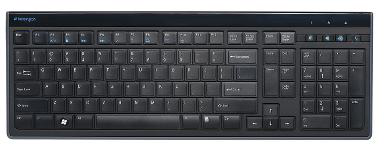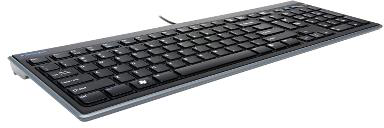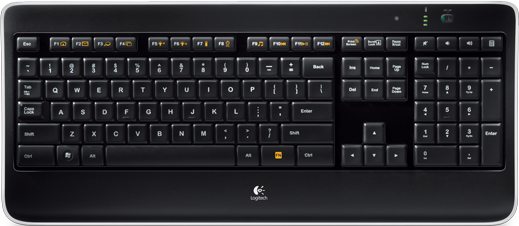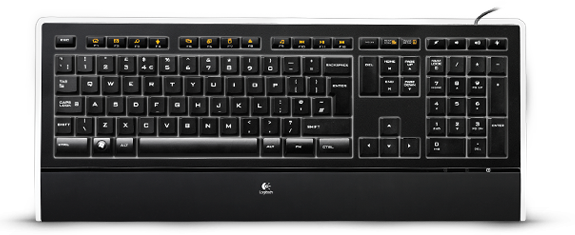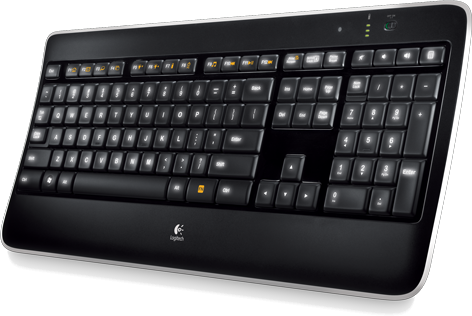Four Keyboards And Four Mice For LAN Party Gamers, Rounded-Up
We have four portable keyboards and a quartet of gaming mice that could turn heads at your next LAN party. We put the boards through a number of performance-oriented metrics, and handed the hardware off to some gamer friends for their opinions, too.
Kensington K72357US And Logitech K800
Why you can trust Tom's Hardware
Kensington K72357US
At just $30, our first entry is on the lower end of the price scale. The keys on Kensington's K72357US are styled after those of your standard laptop. Unfortunately, the feel is similarly cheap, but so is the ultra-quiet operation.
The faux island-style keys have a raised center, which makes cleaning easier than the other three boards in this round-up; none feature true island-style (also referred to as chiclet-style) keys, though.
The Kensington is a no-frills product with no backlighting, extra features, or anything else beyond other simple USB keyboards. The small, compact frame makes for a great portable keyboard for the LAN partygoer on a budget.
Logitech K800
We were (and remain) skeptical of the Logitech K800’s ability to perform consistently in a LAN party situation. With wireless peripherals, you run the risk of stray signals interfering with the connection to your host. The necessary conversion and transmission of the input, and subsequent reception and conversion on the computer’s end, may also introduce unnecessary lag.
However, newer wireless models work just as well as their wired counterparts for most applications, and Logitech has made huge strides in their transceivers. The Logitech Unifying Receiver is barely larger than a male USB connector, and the freedom provided by wireless connectivity is usually a plus.
If you'd rather avoid wireless-related issues entirely, Logitech offers a nearly-identical wired version, simply called the Logitech Illuminated Keyboard, for $20 less.
This sleek, modern board is exceptionally thin. More so than we'd expect from a wireless peripheral, factoring in batteries. A clear plastic rim around the board’s edges looks clean and progressive. The keys are almost soft, and don't shift too much when off-center pressure is applied.
The adjustable backlighting and wireless design contribute to a pricey $100 MSRP. With that said, the K800's wired counterpart also seems a little expensive at $80, considering you give up the freedom of a wireless peripheral.
Current page: Kensington K72357US And Logitech K800
Prev Page Portable Performance Peripherals, Perfect For LAN Party Participants Next Page Razer BlackWidow And Siig JK-US0412-S1Get Tom's Hardware's best news and in-depth reviews, straight to your inbox.
-
atavax i wonder at what dpi's they tested acceleration. It was my understanding that a lot of mice have acceleration issues at different dpi's. I have seen multiple sources that say the G9 has negative acceleration at low sensitivities.Reply -
Trewyy G9x now down to $55 on Newegg :) I should mention that it was a good review, as always!Reply
http://www.newegg.com/Product/Product.aspx?Item=N82E16826104261 -
ShadyHamster ReplyFive programmable buttons near the thumb rest, a mechanical button below the scroll wheel, and a battery indicator set the G500 apart from standard mice.
That should be DPI indicator not battery.
And whats up with pitting 1 mechanical keyboard up against 3 membrane keyboards? Before even reading the article i knew that the mechanical keyboard would be the clear winner, who would care about the loudness of the keys at a lan party, 99.9% of people would have headphones. -
Swordkd Before I bought my Razer mouse(Imperator 2012), I read reviews on newegg and decided to discount the issue that they seemed to be having. After a few months of use, the mice would start to double-click from a single "click". Sure enough, less than 6 months of light to moderate use, my mouse now suffers from this malady once out of every 20 clicks or so. Enough to annoy me.Reply
I will not recommend that brand mouse to anyone ever again. -
kitsunestarwind Logitech G9X is a fantastic mouse, been using mine since they first came out, never a complaint and has led to me having very sharp and accurate aim in games like BF3. Buy one it is worth it!Reply -
alidan das keyboard professionalReply
razor naga
that's my setup...
that said, sound and weight to press are not lower or higher is better... they are prefferences, i personally love the sound that a cherry blue makes and wish it was a bit louder because i make more sound on each key by bottoming them out apposed to activating the switch.
and weight, i hear it more often than not that for gaming heavier presses are better because its less likely to accidently activate.
now, impersonally just because of prior things i have had, i can never recommend razor... but at the same time i use a razor because i want that 12 key pad, and Logitech mouse is even smaller than the already small naga, and i cant get use to its bad form factor... its really the only razor anything i recommend just because there is no other competition that i can tell people to go with outside the small logitech and only if they have small hands.
also, i dont know if it was mentioned, but the razor keyboard from what i remember has such a strict policy, that if you remove a key cap, you void the warranty. there are story's of the s and j key switched, but because of razors warranty, they have to send it in and get it replaced that way, and its a razor product, you know it will fail... the keyboard doesn't have a mounting plate, so its more likely to fail than other mechanical keyboards because of the solder point stress before the keys naturally give out. -
blubbey 'The G500 was reported to be too long,'Reply
I know of course this is personal preference and everyone's different, but either their hands are small or mine are of reasonable size because I can almost cover the entire mouse (fingertips and base of my hand can just about hit the mouse mat at the same time). Unfortunately I don't have much else to compare it to, only random mice however it is larger than any I can remember, so I might just have larger than 'normal' hands.
Something else you might want to consider that others have found is that the scroll wheel is very 'light' to use. I'm indifferent about it seeing as I'm used to light scroll wheels but a few people have raised that point in reviews that I saw before buying it (~$45 on sale). I've also found that the weights are prety much useless, it's already quite a weighty mouse so an extra few grams really didn't matter for me.
